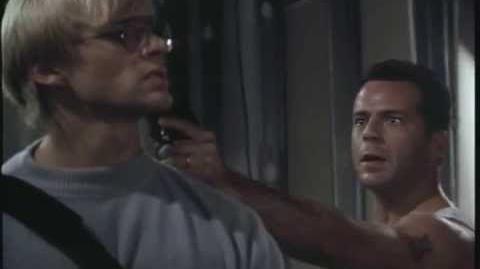This section covers every corner of Die Hard. This includes behind the scenes work such as photos and a documentary of the film.
Origins and Production[]
Die Hard is based on Roderick Thorp's 1979 novel Nothing Lasts Forever, a sequel to his 1966 novel The Detective which had itself been turned into a 1968 film of the same name starring Frank Sinatra. That film was a box office success, and when Thorp wrote the sequel, the studio was contractually obligated to offer Sinatra the lead role despite being 73 years old at the time. Sinatra turned down the role. The story was then changed to have no connection to The Detective and instead pursued as a sequel to the 1985 Arnold Schwarzenegger-starring action film Commando, but Schwarzenegger was not interested in reprising his role. The script was offered to a variety of action stars including Sylvester Stallone, Harrison Ford, and Don Johnson, all of whom turned it down.
Bruce Willis was paid $5 million to star in the film, a figure virtually unheard of at the time for an actor who had starred in only one moderately successful film, and normally paid to the headliners of the time such as Dustin Hoffman and Warren Beatty. Then-20th Century Fox president Leonard Goldman justified the cost stating the film was reliant on its lead actor, while other sources within the studio would state that Fox was desperate for a star for Die Hard, intended to be its big summer action blockbuster, and they had already been turned down by several actors including Richard Gere, Clint Eastwood, and Burt Reynolds. At the time, Willis was largely known for his comedic role as detective David Addison on the television series Moonlighting, and the studio did not believe in his action star appeal. The marketing campaign's initial billboards and posters reflected this, and Willis' face was not a focal point. Die Hard was Alan Rickman's first feature film role.
Director John McTiernan did not want the villains to be terrorists, considering them too mean. He chose to avoid the terrorists' politics in favor of making them thieves in pursuit of monetary gain, believing it would make the film more suitable for summer entertainment. The film's ending had not been finalized by the time filming had begun; one result is that the truck depicted as transporting the terrorists to the building is too small to house the ambulance that was later revealed to be inside it. Other scenes also lacked context: De Govia had built the building's computer room before they knew what it would be used for. Likewise, the character of John McClane had not been fully realized until almost half way through production when McTiernan and Willis decided that he was a man who did not like himself very much, but was doing the best he could in a bad situation. In the original script, Die Hard took place over three days, but McTiernan was inspired to have it take place over a single night by William Shakespeare's A Midsummer Night's Dream.
The corporate headquarters of 20th Century Fox, Fox Plaza in Century City serves as the film's setting, providing both external and internal scenes. At the time of filming, the building was still under construction, and a scene of McClane exploring an unfinished floor complete with construction equipment was real. Production designer Jackson De Govia came up with the idea to use the building. The Nakatomi building's 34th floor where the hostages are held was a recreation of Frank Lloyd Wright's Fallingwater, including a large rock with water dripping from it. Govia's inspiration came from Japanese corporations of the time buying up American products, rationalizing that they had bought Fallingwater and reassembled it in their own building. The building's logo originally was too reminiscent of a Swastika for McTiernan. The final design is closer to a Samurai warrior's helmet. A 380 foot long background painting provided the city backdrop viewed from inside the Nakatomi building's 34th floor. It featured animated lights and other lighting techniques to present both moving traffic and day and night cycles. As of 2011, the painting is still in Fox's inventory and is sometimes used in other films. The scene in which the SWAT Van knocks over a stair railing at the front of Fox Plaza required months of negotiations with Fox to gain approval. The end helicopter scene took six months of preparation and the production was given only two hours in which to film it. It took three attempts above Fox Plaza, nine camera crews, and everyone within 500 feet of the line of flight had to be an employee. The scene of McClane falling down a ventilation shaft and catching onto a lower opening was the result of an accident after Willis' stunt man fell. Editor Frank J. Urioste chose to use the unintentional scene in the final film.
Alan Rickman was dropped 70 feet on a green screen set for his death scene. The shot used was the first take, and the look of fear on Rickman's face was genuine. The DVD text commentary track reveals that the shooting script did not originally feature the meeting between McClane and Gruber pretending to be a hostage; it was only written in when it was discovered that Rickman could perform a rather convincing American accent.
Making of Video[]
Gallery[]
This gallery consists of promotional images, and camerawork of Die Hard.










